This week is a special week at STEMsocial. It is our dark matter week, with a special event to be announced tomorrow (i.e. on Tuesday). The only thing I say for now is that this event is open to everyone, which includes in particular those not versed in science. To know more about this, please follow our community account @stemsocial, and stay tuned for a few more hours.
In the meantime, I take the opportunity to discuss some important generalities about dark matter, complementing the partial information provided in my last two blogs (here and there).
I begin the current blog with a short presentation of what dark matter is and where the idea came from (see previous blogs for more crispy details). I then describe how dark matter is searched for by high-energy physicists from all over the world, and try to share the reasons of my excitement as soon as light is shed on this dark topic (I even try to be funny… that’s probably a side effect of dealing with COVID@home).
For those pushed for time, please consider moving directly to the last section of this blog. As usual, feel free to ask questions, not only on the topic of this blog but also about particle physics in general. Who knows, maybe this will give me extra ideas for the next blogs (on top of the hundreds of topics that I already want to cover).
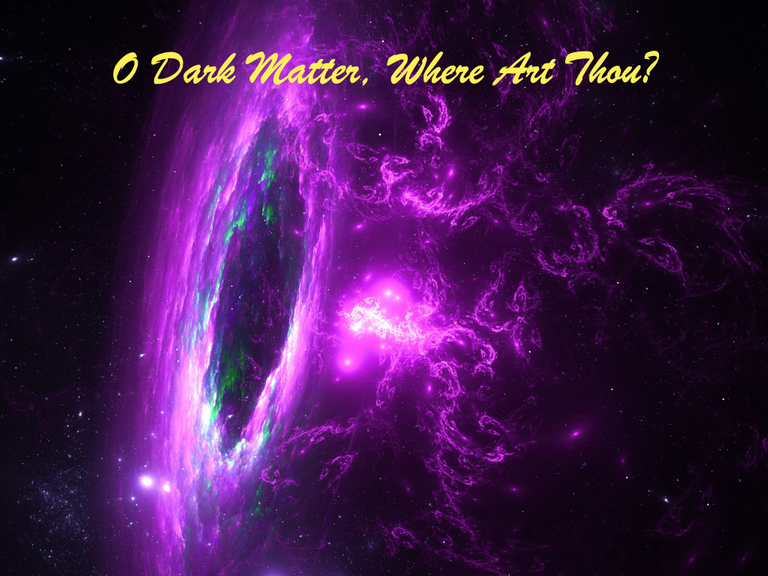
[Credits: Original image from Maklay62 (Pixabay)]
An old dark relic in our universe
As already mentioned several times in my posts, phenomena around dark matter consist of a hot topic in high-energy physics. Whereas dark matter is very motivated by almost 90 years of observations in the sky, the Standard Model of particle physics (that itself accommodates a wealth of data) is not capable to do anything for dark matter. These two points taken together are the source of our excitement when dark matter is at stake: there must definitely be something beyond the Standard Model.
However, where is dark matter coming from? Why do we believe there is such a weird substance in the universe? And what is this substance after all?
The story starts in the 1930s with observations made by the Swiss physicist Zwicky. Zwicky reported measurements of the rotation speed of stars in a distant galaxy, and confront them to predictions from the theory of gravitation. He found out that stars lying very far from the galactic centres rotated too quickly relative to expectations. To accommodate observations, it was postulated that some invisible matter hid itself in galaxies, and was responsible for this too fast motion of stars.
Together with a robust confirmation of these observations in the end of the 1960s and beginning of the 1970s by Rubin, these conclusions are the first proof pointing to the existence of some matter that was different from all known matter. This difference is this darkness, dark matter being dark in the sense that it is transparent to light (in order words, it ignores light). The proof is however indirect.
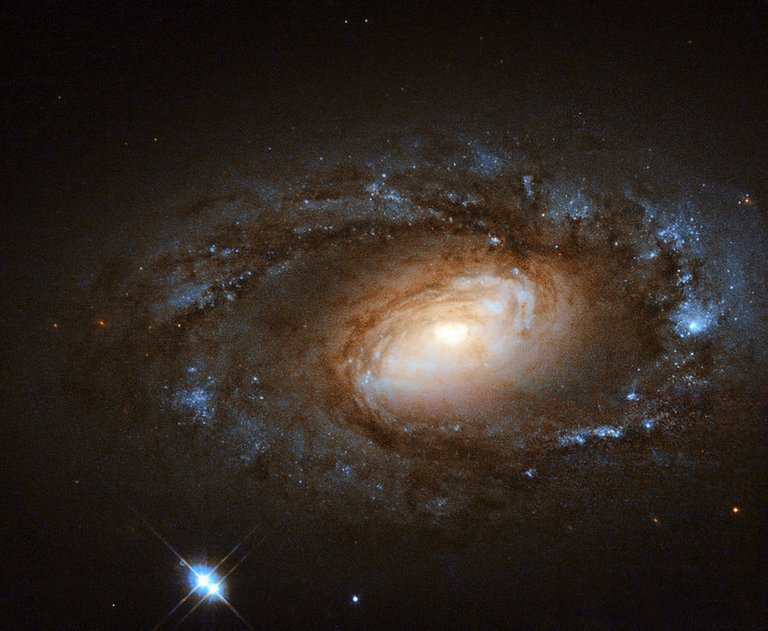
[Credits: NASA (CC BY 2.0)]
To summarise where we are so far, anomalies in the motion of stars in galaxies where found in the 1930s and confirmed in the 1970s. In order to provide an explanation without enforcing Newton’s theory of gravitation to be incorrect, we need to assume that some invisible matter is present in our universe. Is this sufficient as a justification to get excited by dark matter? Probably not, which is why there is more!
In 1965, Penzias and Wilson accidentally discovered that the universe was entirely filled with a radiation whose temperature was 2.73 degrees Kelvin (-270.4 degrees Celsius). We know today that such a radiation, called the cosmic microwave background (or the CMB for short), is well explained by standard cosmology. The important moment in the history of the universe is about 380,000 years after the Big Bang.
Before that key moment, atomic nuclei and their surrounding electrons were not bound together. Matter was therefore electrically charged, the nuclei being positively-charged and the electrons being negatively-charged. Radiation cannot therefore travel much, as it scatters on anything that carries an electric charge (and electrically-charged objects are just everywhere in the universe).
What changed 380,000 years after the Big Bang is that the universe cooled enough to allow nuclei and electrons to form neutral atoms. This changed the game, as radiation got allowed to travel without any limitation in space (there were no more charged objects in the universe). Radiation from that time (i.e. the CMB) is thus still mostly there today, and can be studied.
Precision having improved relative to 1965, we know today that the CMB has not a constant temperature of 2.73 degrees Kelvin. This last value is instead the average CMB temperature, tiny variations in the CBM temperature having been observed. These variations provide a map of what the universe was 380,000 years after the Big Bang. The conclusions obtained from this map are irrevocable: we need dark matter.
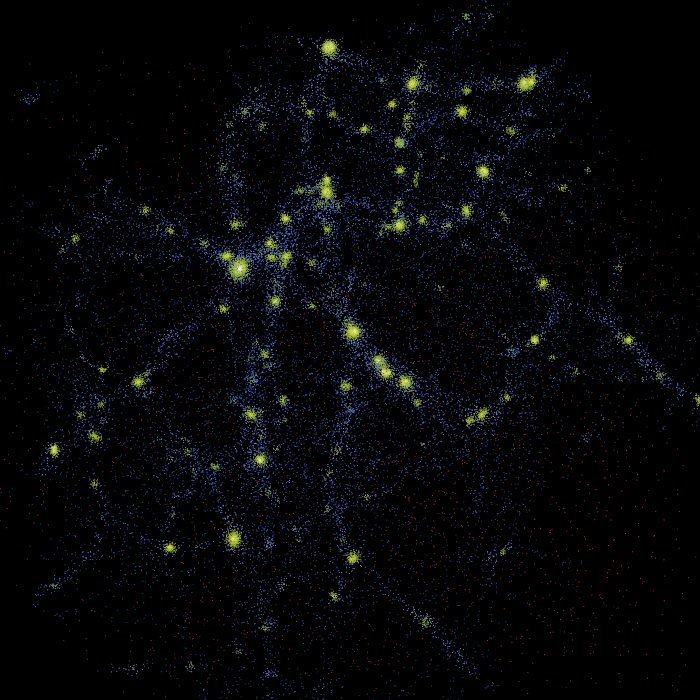
[Credits: Michael L. Umbricht (CC BY-SA 4.0)]
This need can however get wilder. Without dark matter the structure of the galaxies in terms of the stars they contain, and the structure of the universe in terms of the galaxies it contains, would indeed be different from what we observe. In other words, the structure of our universe as it is today requires the presence of dark matter.
We can also mention gravitational lensing as an other indirect proof for dark matter, as the presence of dark matter everywhere in the universe influences the way light travels (and this can be measured).
So, there must be dark matter in the universe to accommodate a bunch of observations. These are however all indirect evidence, and a direct observation of dark matter is still missing. What I want to discuss in the rest of this blog is what physicists do in order to fill this gap, catch dark matter and observe it in all its glory details.
The almighty graph of dark matter experimental searches
Existing searches for dark matter rely on two assumptions. First, we need an elementary particle that can play the role of dark matter. Second, dark matter is expected to interact with the Standard Model of particle physics, on top of its gravitational interactions.
The way to realise this in a concrete model was explained in this earlier post. For the present blog, let’s avoid any related subtleties and consider instead that we have a dark matter particle that interacts with the Standard Model.
This dark matter particle and its interactions with the Standard Model pave the way to processes involving two dark matter particles and two Standard Model particles. These processes are the roots of all on-going searches for dark matter. This connection is illustrated in the beautiful (hmmm…) homemade figure below.
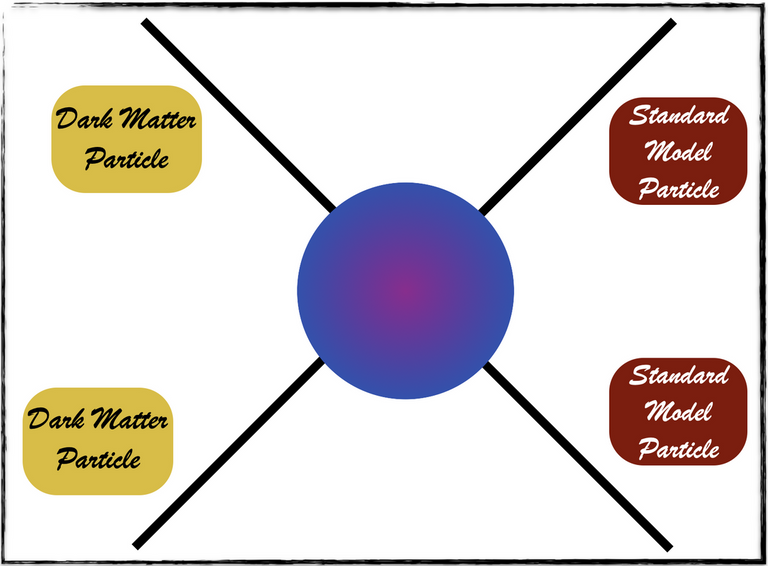
[Credits: @lemouth (this can be guessed I imagine…)]
What can we see in this figure? That’s quite simple. We have two dark matter particles (the thick lines on the left of the figure) that can react in some way (the coloured blob in the middle) and produce two Standard Model particles (the thick lines on the right of the figure).
However, this figure has more physics inside. We can have a look at it from the right to the left. In this case, we would have two Standard Model particles that would react to produce two dark matter particles. This is the inverse reaction of the previous one.
But there is even more. We can additionally have a look at this figure from the top to the bottom (or to the bottom to the top; that’s the same). In this situation, we have one dark matter particle and one Standard Model particle (the upper part of the figure) that scatter, and this gives rise to the same dark matter particle and the same Standard Model particle in the final state (the lower part of the figure), although with different kinematic properties.
This graph can thus be read in three different manners, which correspond to the three existing ways to search for dark matter experimentally.
A three-fold way to search for dark matter
It is now time to explain how the above diagram can be used to directly discover dark matter, which naturally brings us to the main meat of this blog. The first manner I discuss is when the graph is read from left to right. We thus consider a process in which two dark matter particles annihilate into two Standard Model particles.
In order for such a process to happen, we need to focus on regions of the universe that are dense in dark matter, so that we could actually have two dark matter particles that can get to know each other very closely. Such regions exist (which is a good news for the considered process to happen). They include, for example, the centre of the Milky Way or dwarf spheroidal galaxies, i.e. galaxies with very little stars and mostly made of dark matter.

[Credits: 2MASS (public domain)]
There are therefore regions of the universe in which Standard Model particles can be produced from dark matter annihilations. Once produced, those final-state Standard Model particles contribute to the flux of cosmic and gamma rays traveling into space. These can be detected by satellites orbiting around Earth, as for instance with the Fermi-LAT telescope which measures the flux of gamma rays reaching Earth as a function of the gamma ray energy.
In order to find a signal of dark matter, we compare the observed fluxes of gamma or cosmic rays arriving on Earth with expectations from various astrophysical sources (i.e. the background to our signal). No excess relative to astrophysics has been found so far…
The second way to seek dark matter on the basis of the above diagram is to read it from right to left. As already mentioned, this is the reverse process of the one giving rise to cosmic and gamma rays. Here, two Standard Model particles annihilate and give rise to the production of a pair of dark matter particles.
As dark matter particles are often considered much heavier than any Standard Model particle, the latter must be accelerated to enable dark matter production. This stems from Einstein’s theory of special relativity. Mass is a specific form of energy, so that more energy (obtained through particle acceleration) is needed to ensure that heavier particles could be produced.
The associated experimental context is exactly the one put in place in big particle accelerators such as the Large Hadron Collider at CERN. An example of collision in which dark matter could have been produced is shown in the figure below.
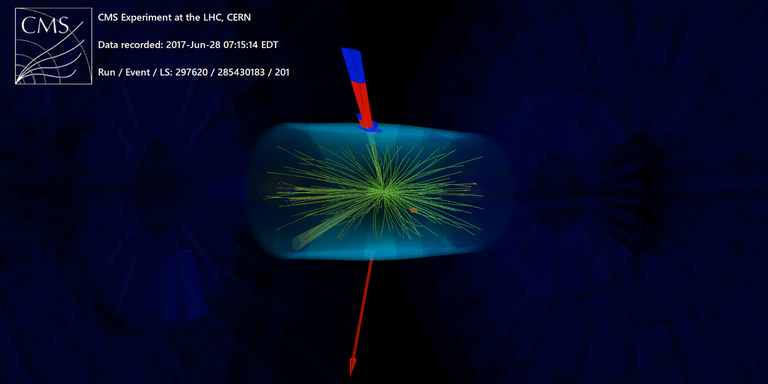
[Credits: CERN]
The interesting question is definitely about how can we relate the above detector record to the production of dark matter? This comes from one of the golden rules in physics: energy and momentum conservation. In any process, these two quantities are conserved. That’s a fact.
Consequently, this can be verified in any collision. Let’s take the above figure. We account for all energy deposits (the red and blue hits in the upper part of the figure) and all tracks (the green lines in the middle of the figure), and then check whether energy and momentum are conserved. Interestingly enough, we can observe that something is missing (the red arrow in the lower part of the figure). Such a missing energy and momentum is associated with particles leaving the detector invisibly (for instance because of their very feebly-interacting nature).
Missing energy can thus be linked to dark matter production, as dark matter is very weakly-interacting and would leave a detector invisibly if produced. This process is however not a background-free process, as a missing energy signal could come from the Standard Model too.
The results of all analyses expecting to find dark matter are for now compatible with this Standard Model background. No signal again…

[Credits: SLAC]
It is now the time to discuss the last way to probe dark matter, when our almighty diagram is taken from its top part to its lower part. This process can be seen as a reaction in which a dark matter particle hits a Standard Model particle at rest, scatters and generates the recoil of the Standard Model target. This phenomenon is exploited in dark matter direct detection experiments (see the above picture).
Recent examples of such direct detection experiments include the Xenon-1T detector. In this case, we have a huge tank filled with liquid xenon, and we patiently wait as this tank is traversed by a wind of dark matter constantly blowing on our planet. When a dark matter particle of the wind hits a xenon atom (its nucleus or one of its orbiting electrons), a small recoil can be measured.
Whereas such an event is very rare (due to the weakly-interacting nature of dark matter), we have a huge detector (1 ton of liquid xenon, that will soon be upgraded to several tons of liquid xenon). Therefore, by waiting during a sufficiently long time, we can expect to see some events.
Unfortunately, once again… no signal has been found. Dark matter is hence much more elusive than in most optimistic scenarios.
I didn’t have time for such a long post... What is all of this about?
Dark matter is probably the most elusive substance ever. We know it has to be there thanks to various sources from cosmology: galaxy rotation curves (i.e. the motion of stars around galactic centres), the cosmic microwave background or the formation of the large-scale structures in the universe. However, these strong motivations are all indirect, and dark matter still needs to be directly produced and observed.
We are looking for this in three different fashions, all originating from the fact that if there is a dark matter particle and if this particle interacts with the Standard Model, we automatically have reactions involving two Standard Model particles and two dark matter particles.
- Two dark matter particles can annihilate into two Standard Model particles. That gives rise to cosmic ray and gamma ray signals that can be observed in satellite experiments orbiting around Earth.
- Two accelerated particles can annihilate to produce dark matter. This is the strategy followed at particle accelerators that seek a dark matter signal (i.e. a missing energy signal) in data.
- One dark matter particle can hit some Standard Model particle and make it recoiling. Observing such a recoil is what direct detection experiments aim to do.
Despite of this variety of searches, dark matter still escapes us today. Most proposed dark matter models in particle physics therefore get more and more constrained. However, there is still room for dark matter to be viable, and the future is coming with great expectation (new experiments, more data, more precision, etc.).
I hope this introduction, which I end here, was interesting enough. Please feel free to ask questions (on this blog or on particle physics and cosmology in general), and provide feedback (both positive and negative ones) in the comment section.
I wish everyone a very nice week, and see you tomorrow from @stemsocial for a special announcement related to dark matter!
COVID in the house? Oh no. You just slipped that in. I hope everyone is OK.
You and I are apparently fans of the same movies. Previously you referred to a Hitchhiker's Guide to the Galaxy. This week it's O Brother Where Art Thou. If you tell me you also are a fan of the The Blues Brothers (original, probably before your time), that's the trifecta of movie fandom.
Of all your blogs this one for me was the most completely and easily (there was nothing easy about it😇) understood. Knowledge is cumulative and your writing is great (and funny).
I believe I understand the basics, almost intuitively. There must be dark matter because otherwise the standard model doesn't work and the standard model has to work or the universe as we know it doesn't make sense.
I have a couple of question that arise not so much about your search for the elusive dark matter. One is about Newtonian physics. I thought Einstein's Theory of Relatively disproved Newtonian principles. And yet you say here that
The second question has to do with black holes: I always associated dark matter (perhaps incorrectly) with black holes. Black holes (in the popular consciousness) are supposed to consume energy. However, in your blog you explain that
So from the dark matter we can get energy? (Cosmic and gamma rays)
Now I recognize that I may be mixing apples and oranges. But, I'm at the stage of learning where I am associating ideas. In other words, your blog and your information is beginning to have real-world context for me, even if I'm on the wrong track 😆.
This is a great blog, @lemouth, and the summaries really do help.
Hope everyone in your house gets well soon, if they are not well now. Take care of yourself.
Regards,
Lol. I'm a big fan of "Feynman Style" diagrams. Simple, yet they contain a lot in them, and they are very effective!
I read your reply to another comment, and I think dark matter takes the "boring" route in my opinion.
This relates to the question I asked on your previous post about the subject. I can imagine some data might come in one day about the energy/momentum imbalance we discussed, which can prove dark matter's interaction gravitationaly, but personally I think that will be the only way it interacts with the standard model particles. (I'm no fun :p)
Regardless. Any sort of detection would be exciting nontheless!
Thanks for the detailed article about dark matter, shedding the light on it is no easy matter ;)
Thanks a lot for this nice comment and all these questions, even if one of them is a bit dark to me (see below) ;)
They are effective to convey a message. Now, if you want to make precision predictions, they quickly become a nightmare for various reasons (infinities, combinatorics, etc.). Excepted for this, I agree that they are cool ^^
It is more than fine to have such an opinion. This will maybe end into a very good idea to detect dark matter in a novel way. Or not so novel ;) At the end of the day, what matters most is that all options are considered so that we won't miss it.
I am not sure to follow this question, and I am afraid you will need to clarify it.
The energy/momentum imbalance is the way used to detect signals of invisible particles at particle colliders. Showing a significant excess of collision events featuring a large momentum imbalance relative to the Standard Model (as such an imbalance also arises in the Standard Model) is sufficient to conclude that we have something new, heavy and invisible.
That is possibly a good candidate for dark matter (as this particle would have the right properties to be dark matter). However, how to conclude about anything gravitational here? The masses of the involved objects are way too low. We thus know for sure that any gravity effect is negligibly small.
I think you got what I meant by that last quote, because you explained it very well.
The negligibly small gravitational effect is what I had in mind as a possibility for it to be detectable in the future by some precision enhancements. (I have no idea if that can be possible, was just a thought)
From what I understand on how the momentum detection happens, is by measuring the radius of the curvature and the arc length of the charged particles' trajectories?
So in principle, if we can get super precise, even the tiniest gravitational effect should have an effect on the angle.
Hopefully I'm not way off with my understanding about it :p
Unfortunately, we are talking about really negligible effects. To give an order of magnitude, gravity is 10-40 times smaller than the strong force. Therefore, any associated effects are well below any conceivable detector resolution.
There is however one way out. If we live in more than 3 spatial dimensions, then heavier copies of the graviton could be around and leave some observable imprints in data. That is however a different story :)
Great article on an incredibly fascinating topic.
So dark matter ignores light as you say, but at the same time bends light due its gravitational interactions which it has in common with its sibling, the standard matter. In a way, similar to what standard matter black holes do, right? Hence the gravitational lenses caused by an otherwise invisible substance. So here is my question. By which observation can it be ruled out that dark matter is nothing but a gigantic network of countless standard matter black holes? If those had formed early on in huge quantities and scales, couldn't that explain the inhomogeneities wich we observe in the visible universe too?
Very much looking forward to this special event ;)
Thanks for passing by and the question.
In fact, I was a bit sloppy here, for simplifications reasons. Two things are in fact mixed.
This second point applies to black holes too. They will modify the structure of spacetime and hence (drastically) impact the trajectory of light traveling into space.
Now let's move on with your question.
This hypothesis has been made, and studied. This is what is called primordial black holes. This assumption is not ruled out, but black holes enough are not sufficient to explain all observations. We indeed need a second source of dark matter in this context. On the other hand, the "no black hole" hypothesis is not rejected (at least "yet").
I hope this answers the question and clarifies the situation. Please let me know.
PS: This actually extends what I answered @agmoore, who I tag so that she could get more information.
Thank your for your answer. I must say I'm almost shocked that this idea had been brought up and discussed already as a serious hypothesis. I can only assume that I some how picked this up when watching one of the many documentaries about black holes without actually remembering. Very interesting.
Right after sending my initial comment, I thought about the following. I assume that after the big bang, the universe first had to cool down below a certain threshold so that black holes could even start to form. Therefore, a precondition for the primordial black hole theory would be that the inhomogeneities can not have started to materialize before the temperature hat fallen below that temperature. So my next question would therefore be, do our computational models produce enough temporal resolution to be sure regarding the order of these events? Or does this thesis still require to simply assume that black hole formation preceded the inhomogeneities?
EDIT: I just skimmed the wikipedia article which you had linked in your answer. Thanks for that! So we are talking about events within the first second of the universe's existence. That's beyond mind-blowing. 😅
We should never underestimate the wealth of ideas for physics beyond the Standard Model. It is definitely a very wild area ;)
I will try to answer your question, but please note that this lies a bit far from what I do, so that my knowledge on this topic is very partial.
That's correct. We need some gravitational collapses for the primordial black holes to form. Note however that this happens well before stars were formed, so that this has nothing to do with the way "usual" black holes are formed. We need obviously a trigger, that either materalises itself as a quantum fluctuation of the energy density of the universe, or relies on a more fancy models (those even exist ;) ).
I am afraid I didn't get this question. Sorry... Do you mind clarifying / elaborating?
I really love the diagram approach showing the connection between dark matters and standard model particles. It makes the rest of the post very easy to understand.
Is there a chance that dark matter will not interact with standard model particles? If yes, wouldn't it make more sense to rather focus on the particle acceleration going on in CERN instead of spending time and resources on the Xenon-1T detector experiment with lower chances of detecting dark matter?
Do you know that this diagram is used in many particle physics talks. It is a schematic representation of a class of Feynman diagrams, that is a way to represent quantum field theory computations in an easy-to-grasp manner ;)
Yes, it is possible that dark matter interacts only gravitationally, and nothing more. In this boring case from a particle physics standpoint, none of the three ways we use to search for it would work. Gravity is too weak at the level of a single elementary particle (which is the context for current searches) to lead to any observable signal.
If we have a connection with the Standard Model, then all three classes of searches are needed as they are in fact complementary. In configurations where some are weaker, others take over. As the where depends on the model (which we don't know), we need to be pragmatic and consider them all. In some sense, we maximise the chances.
Although I read the whole post, I also really appreciate the recap at the end. It helps arrange the things I just read nicely in my head!
You made me quite curious about what that event actually is :-)
Thanks for this feedback. I believe a recap is necessary once the length of the post crosses some threshold (that I usually cross ;) ).
For the event... see you tomorrow ;)
Exciting! :-D
Excellent article, thank you very much. If all attempts to detect dark matter fail, is there any alternative in physics, say a plan B, any serious theory to account for these anomalies?
Thanks a lot for passing by and this very interesting question.
First of all, one should note that current experiments do not have the capacity to explore all possibilities for dark matter. Therefore, not finding anything does not necessarily mean that dark matter is not there. This would only mean that if we have dark matter, it will be harder for us to find it (as we may need to design new strategies for instance).
For that reason, while current experiments are running, the next generation of experiments are being designed and built, with an increased sensitivity and possibly ways to probe configurations to which we are not sensitive yet. For now, prospects are great for the next couple of decades (at least). We still have ideas and there is still room for dark matter to be there.
I guess your question is about what will happen if dark matter is eventually not there? Well, I don' know. Maybe MOND would be the right theory after all (i.e. a theory in which the way gravity works is modified), or maybe dark matter will just be more exotic than naively thought (I doubt that we will be able to probe all options within the next 50 years, at least). To conclude, what is important is that we have options to explore, as this means we will have ideas about how to probe the full thing further and maybe revolutionise our understanding of cosmology (the currently best model includes dark matter).
I know I didn't answer properly the question, but I guess there is no good answer too ;)
Thank you very much! Yes, my question was aimed at just that, whether there was any other theory that could give an explanation dispensing with dark matter, in case in the long run all attempts to find it failed. I read a bit about MOND theories and, although my knowledge of physics is not enough to understand them more than superficially, they don't seem to have much acceptance in the scientific community. So, as you say in your answer, the best way forward, at least for a few decades, is to keep looking for dark matter.
There are a bunch of physicists who work on modified gravity theories (that include MOND). The reason why most of us focus on dark matter is because in terms of significance this idea is stronger. This however does not mean that modified gravity theories are excluded and that no one cares about them. They are tested too.
At the end of the day, what is important is that all paths are explored, which is the case.
Thanks for the answers! Dark matter seems like a very exciting field to be working in at the moment.
I fully agree. :)
This is why I have dedicated a significant fraction of my research time to dark matter during the last 5-6 years.
It's quite suspicious that all 3 ways of searching for dark matter have failed.
If you can see the event, it's not a dark matter event!
I don't understand why this is suspicious? There is in principle a vast parameter space to cover (in particular as the dark matter mass can be anything), and only a fraction of it is covered. Therefore, even if we have three ways to look for dark matter and that these three ways are complementary, we are by far not sensitive to all possibilities.
As a consequence, the no-signal result is not that negative.
I can smell it.... I am COVID-negative ;)
I'm not the brightest when it comes to physics but this topic got me curious having seen LMAC & STEMsocial partner on this means it's huge. so ran over to know what it's all about and i see why.
Thank you for breaking things down to it's simplest form. I'm still reading on the subject and would head over to your last two blogs for more insight. An interesting area of research.
Thanks for passing by and giving my blog a chance :)
Feel free to come back to me if you need clarifications about anything. I would be very happy to help and explain further what is needed to clarify.
Is it the reason stars stay in a constant position without attracting each other (due to the dark matter between them). Is it black area between stars called as dark matter
I am not sure to have understood the question. Let me try to answer anyways. From there, feel free to come back to me so that we could clarify your question together.
Stars do not stay in constant position. They actually move quite fast in the galaxy, at speeds easily reaching hundreds or thousands of km/s. Their motion consists of orbits around the centre of the galaxy, and the rotation speed can be measured (in the same way that Earth takes a year for one orbit around the Sun).
From this measurement (and other pieces of data), we know some invisible mass should be around (i.e. dark matter) following a certain distribution. To be precise, it forms a halo that is assumed to extend much further than the visible limits of the galaxy.
This distribution however lies all over the galaxy, and we even have a dark matter wind blowing on Earth (coming from the fact that nothing is static in the universe).
Does it help?
after watching this I got it.
It is such an interesting and exciting topic.
Definitely. This is one of the reasons why I am working on this since about 2015 ;)
The rewards earned on this comment will go directly to the person sharing the post on Twitter as long as they are registered with @poshtoken. Sign up at https://hiveposh.com.
Thanks for your contribution to the STEMsocial community. Feel free to join us on discord to get to know the rest of us!
Please consider delegating to the @stemsocial account (85% of the curation rewards are returned).
You may also include @stemsocial as a beneficiary of the rewards of this post to get a stronger support.
Your content has been voted as a part of Encouragement program. Keep up the good work!
Use Ecency daily to boost your growth on platform!
Support Ecency
Vote for new Proposal
Delegate HP and earn more
Congratulations @lemouth! You have completed the following achievement on the Hive blockchain and have been rewarded with new badge(s):
Your next target is to reach 73000 upvotes.
You can view your badges on your board and compare yourself to others in the Ranking
If you no longer want to receive notifications, reply to this comment with the word
STOPCheck out the last post from @hivebuzz:
Congratulations @lemouth! You received a personal badge!
Wait until the end of Power Up Day to find out the size of your Power-Bee.
May the Hive Power be with you!
You can view your badges on your board and compare yourself to others in the Ranking
Check out the last post from @hivebuzz:
Congratulations @lemouth! You received a personal badge!
Participate in the next Power Up Day and try to power-up more HIVE to get a bigger Power-Bee.
May the Hive Power be with you!
You can view your badges on your board and compare yourself to others in the Ranking
Check out the last post from @hivebuzz: